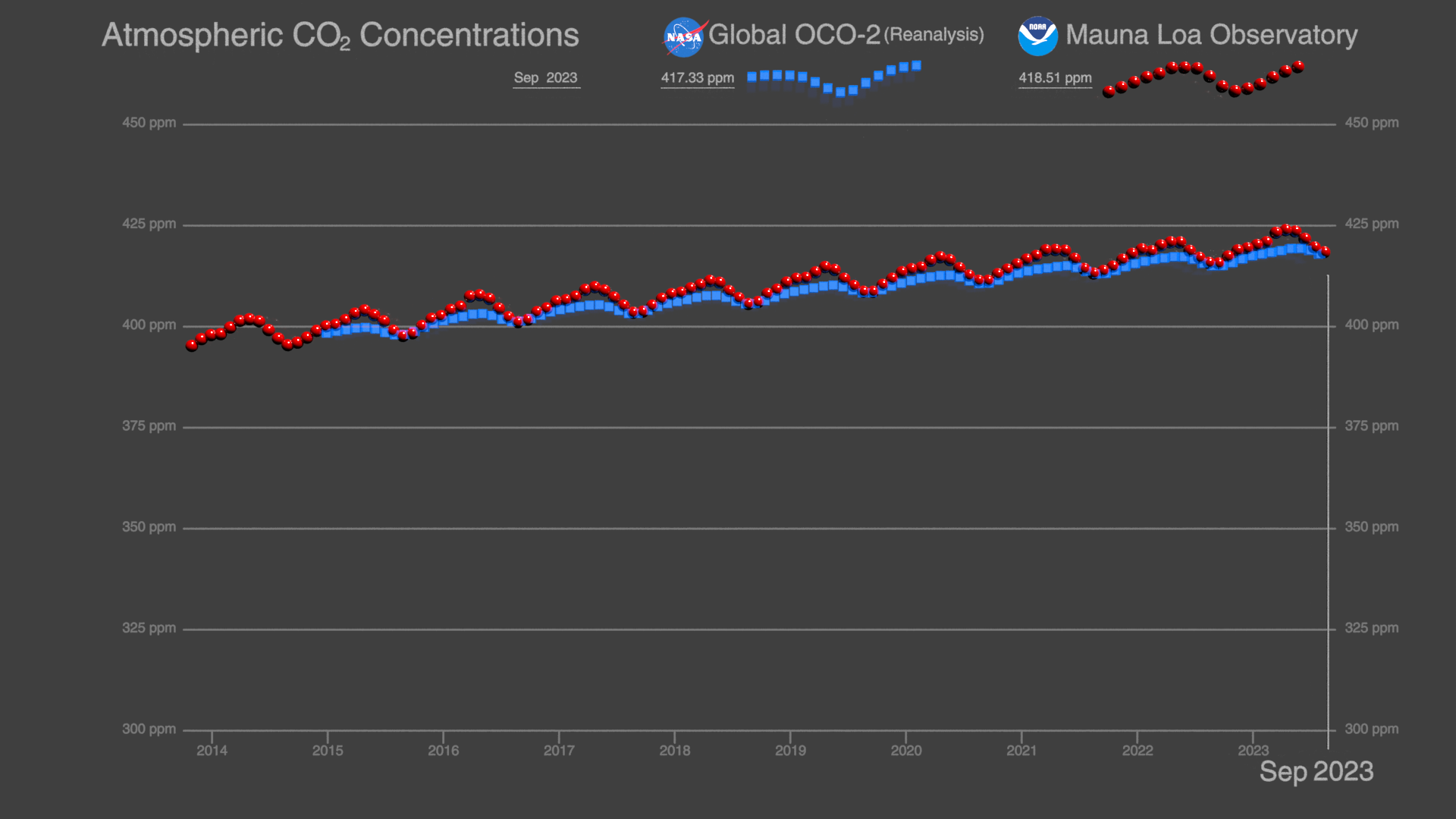ODIAC: a map of human made carbon dioxide emissions
ODIAC (Open-source Data Inventory for Anthropogenic CO2) map for December 2021.
The Open-source Data Inventory for Anthropogenic CO2 (A.K.A. ODIAC) is a global high-resolution (1x1km) emission data product for fossil fuel carbon dioxide (CO2) emission. ODIAC was originally designed and developed under the Greenhouse gas Observing SATellite (GOSAT) project at Japan’s National Institute for Environmental Studies (NIES). Since then, ODIAC has been maintained at the Universities Space Research Association (USRA) in collaboration with NASA, NIES and the Appalachian State University. ODIAC pioneered the combined use of space-based nighttime light data and individual power plant emission/location profiles to estimate the global spatial extent of fossil fuel CO2 emissions. ODIAC has been a key input data for NASA’s carbon modeling. ODIAC has been also widely used in the international science research community for a variety of applications across key policy relevant scales (global to local).

ODIAC (Open-source Data Inventory for Anthropogenic CO2) map for December 2021. This equirectangular map is provided for wrapping to a sphere.
Credits
Please give credit for this item to:
NASA's Scientific Visualization Studio
-
Visualizer
- Mark SubbaRao (NASA/GSFC)
-
Technical support
- Laurence Schuler (ADNET Systems, Inc.)
- Ian Jones (ADNET Systems, Inc.)
-
Scientists
- Lesley Ott (NASA/GSFC)
- Tomohiro Oda (USRA)
Release date
This page was originally published on Friday, June 30, 2023.
This page was last updated on Sunday, May 5, 2024 at 11:38 PM EDT.
Papers used in this visualization
Oda, T., Maksyutov, S., and Andres, R. J.: The Open-source Data Inventory for Anthropogenic CO2, version 2016 (ODIAC2016): a global monthly fossil fuel CO2 gridded emissions data product for tracer transport simulations and surface flux inversions, Earth Syst. Sci. Data, 10, 87–107, https://doi.org/10.5194/essd-10-87-2018, 2018.
Datasets used in this visualization
-
ODIAC (Open-source Data Inventory for Anthropogenic CO₂)
ID: 1186The Open-source Data Inventory for Anthropogenic CO₂ (A.K.A. ODIAC) is a global high-resolution emission data product for fossil fuel carbon dioxide (CO₂) emissions. ODAIC was originally developed under the Greenhouse gas Observing SATellite (GOSAT) project at Japan’s National Institute for Environmental Studies (NIES). Since then, ODIAC has been maintained at the Universities Space Research Association (USRA) in collaboration with NASA, NIES and the Appalachian State University. ODIAC pioneered the combined use of space-based nighttime light data and individual power plant emission/location profiles to estimate the global spatial extent of fossil fuel CO₂ emissions. With the innovative emission modeling approach, ODIAC achieved the fine picture of global fossil fuel CO₂ emissions at a 1x1km, possibly the most beautiful global picture of human-made emissions. ODIAC was specifically designed for atmospheric CO₂ simulation applications, specially analyses using CO₂ data collected by satellites, such as GOSAT and NASA’s Orbiting Carbon Observatory missions. ODIAC has been a key input data for NASA’s carbon modeling. As seen in a number of publications in the literature, the ODIAC emission data product has been also widely used in the international science research community for a variety of research applications (e.g. carbon budget analysis, urban emission study, observing system design experiments, and etc.) across various key policy relevant scales (global to local).
Credit: Tomohiro Oda, Shamil Maksyutov (2015), ODIAC Fossil Fuel CO2 Emissions Dataset (Version name1 : ODIACYYYY or ODIACYYYYa), Center for Global Environmental Research, National Institute for Environmental Studies, doi:10.17595/20170411.001. (Reference date2 : YYYY/MM/DD)
This dataset can be found at: https://db.cger.nies.go.jp/dataset/ODIAC/
See all pages that use this dataset
Note: While we identify the data sets used in these visualizations, we do not store any further details, nor the data sets themselves on our site.

